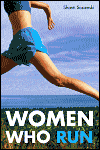Book review: Women Who Run

Women Who Run, by Shanti Sosienski
Reviewed by Melanie Mock
The runner I most admire is my sister, Amy. She hadn’t run a step — save for PE class — until several years ago, after the added weight of birthing three kids sent her shuffling to the track in cotton shorts and too-small shoes. In a few months, my sister was winning local races; in the four years since, she has run twelve marathons. Amy is a dedicated, conscientious, hard working, free spirited runner: characteristics she carries into her life and into her various roles as wife, mother, and nursing student.
I thought about Amy often while reading Shanti Sosienski’s new book, Women Who Run. In many ways, my sister’s becoming-a-runner narrative mirrors that of the seemingly ordinary women Sosienski features: like my sister, many began running almost as a lark and quickly developed a passion for the new sport into which they had stumbled. In time, the women of Sosienki’s book became remarkable because of their unique experiences with running — experiences that make them admirable not necessarily because they are the fastest or best, but because of their distinctive contributions to running, to their families and communities, to their worlds.
Because Sosienki admirably focuses on lesser-known runners, there are few recognizable names in her text: there is no Joan Samuelson here, no Grete Waitz, no Paula Radcliffe. The book’s first chapter provides a compelling yet succinct history of women’s running, showing that even the pioneers of women’s marathoning have slipped into relative obscurity; for example, the daring covert entries of Bobbi Gibb and Katherine Switzer in the Boston, despite their symbolic import for gender equity in sport, have become a curious footnote in the history of that storied race.
In some part, Sosienki’s first chapter suggests, the lack of recognizable names in women’s running reflects the short history of women in the sport. After all, she notes, women were deemed too weak to run anything more than a half mile until 1972, when the 1500 meters was added to the Olympics. In 1984, Samuelson won the first women’s Olympic marathon, and naysayers had to admit that a woman’s uterus would not explode were she to run over a mile — though, of course, some remained skeptical.
Despite lives of relative obscurity, the women in Sosienki’s book challenge any long-held mythologies about feminine frailty. For example, Sosienki tells the story of Diane Van Deren, who ran the Iditarod Trail Invitational carrying 42 pounds of her gear; Van Deren tore her groin muscle part way through the 350 mile race, but still “managed to go about a hundred and eighty miles” dragging her injured leg. Equally inspiring is the life story of Louise Cooper, finisher of seven Hawaii Ironmans, over sixty marathons, and twelve ultra runs, who placed ninth overall in the notoriously difficult Badwater Ultra (a 135-mile race through Death Valley, in July), a year after her diagnosis of type IV breast cancer.
The book does a great job of balancing such tales of superwoman strength with the unique stories of women who have contributed to running in other, no less inspiring ways. Sosienki writes about Shari Kunz, who ran her first marathon in 2001 in honor of her brother, who was dying of cancer; then, motivated by that achievement, Kunz started a local chapter of Girls on the Run in her Idaho community. Girls on the Run, a national organization, provides training as a way to “give girls strength, courage, and ability to complete tasks and steer themselves from girl to young women.” By 2005, Kunz’s group had 100 girls enrolled each year.
Asra Nomani has experienced that strength and courage firsthand, yet without the support of a specific training program like Kunz’s. As a Muslim woman, Nomani has known full well what her patriarchal culture expects of her, but has used running to counter such rigid demands. A journalist for the Wall Street Journal, Nomani continued to run in Pakistan while covering post 9/11 Middle East issues, even after her good friend, Daniel Pearl, was kidnapped and killed. Now back in the United States, Nomani celebrates the freedom running has given her, aware that most Muslim women are not afforded a similar freedom.
Far more than a collection of inspiring stories, Women Who Run is a celebration of running sisterhood. Sosienski challenges the stereotype of the solitary runner, trudging mile after lonely mile, showing instead that good runners — and, indeed, good women — are shaped by the family and friends who surround them. For runners especially, Sosienki’s book offers an important reminder that, often, our most cherished experiences take place because of other people, not because of our own athletic achievements.
Yet Women Who Run should not be considered solely a text for runners. While those who run might resonate most with the women’s experiences, I imagine most readers will be readily inspired to do something: travel to a new place, work harder at a mundane job, volunteer in the community or, perhaps, take a few faltering steps out the front door. While Sosienski’s book is an easy read for a lazy afternoon, I cannot imagine any reader feeling lazy upon finishing it. More likely, you will want to lace up your shoes and cover a few miles, by yourself or with your favorite runner.
I think I’ll call my sister.
Melanie Mock is a lifelong runner. She teaches English at George Fox University in Newberg, Oregon.
Recent Vagablogging.net guest book reviews include Aly Young’s review of Tales from the Expat Harem, and Cedar Van Tassel’s review of Warning: Failure to Buy This Book Could Result in Death or Serious Injury.

November 2nd, 2006 at 9:49 am
Thank you for the wonderful review! I am so glad you liked the book. The feedback I have been getting from women around America is amazing. Perhaps I’ll have to write “Women Who Run Again”
Cheers, Shanti Sosienski
http://www.shantisos.com/womenwhorun